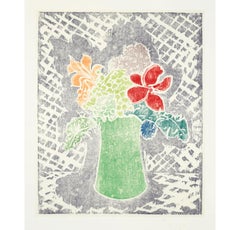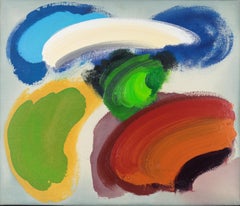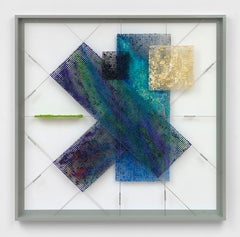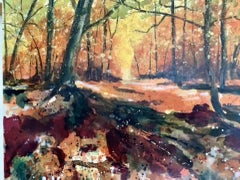William Tillyer Paintings
British, b. 1938
William Tillyer is a celebrated British painter and watercolourist, whose work has been shown frequently in London and New York since the 1970s. Tillyer was born in Middlesbrough, and studied painting at Middlesbrough College of Art. He then went on to study at the Slade in London. He began to make radically experimental work which raised questions about the relationship of art to the world, and of man to nature. The 1970s saw Tillyer return to printmaking with renewed vigour, using a variety of techniques from etching to five-tone screenprinting, to create lattices that Pat Gilmour, Head of the Print Department at Tate, described as "a cool and unpeopled world...in which to reflect the surrounding flux of nature." He has been invited to work internationally, including Cadiz, Spain; Tobago, Republic of Trinidad and Tobago; Cill Rialaig Project, Co. Kerry, Ireland; Melbourne, Australia, and was a visiting professor at Brown University, USA; Bath Academy of Art; and the Chelsea School of Art. Tillyer has exhibited internationally, and his work can be found in the collections of major institutions including the Arts Council of Great Britain; the Brooklyn Art Museum, New York; Fort Worth Art Museum, Texas; Middlesbrough Art Gallery; MOMA, New York; The Art Gallery of Western Australia, Perth; Tate Gallery, London; and the Victoria & Albert Museum. to
1
2
Overall Width
to
Overall Height
to
2
1
1
1
1
1
1
1
2
2
2
1
1
90
780
713
712
687
2
3
Artist: William Tillyer
The Linthorpe Vase, from York Vases, Woodblock Print by William Tillyer, 1981
By William Tillyer
Located in Kingsclere, GB
The Linthorpe Vase, from York Vases, Woodblock Painting by William Tillyer B. 1938, 1981
Additional information:
Medium: Woodblock
Dimensions: 106 x 75 cm
41 3/4 x 29 1/2 in
Category
20th Century William Tillyer Paintings
Materials
Wood
Untitled from the Westwood Paintings
By William Tillyer
Located in London, GB
William Tillyer
Untitled (The Westwood Paintings)
1989
Acrylic on canvas
61 x 71.1 cms (24 x 28 ins)
WT9778
Category
1980s American Modern William Tillyer Paintings
Materials
Acrylic
Price Upon Request
Small Green Field with Landscape - The Mulgrave Tensile Wire Works
By William Tillyer
Located in London, GB
William Tillyer’s Recent Paintings
by John Yau
Time has proven William Tillyer to be the most adventuresome painter of his generation. This is no small achievement. In a country kno...
Category
2010s Contemporary William Tillyer Paintings
Materials
Found Objects, Mixed Media, Acrylic
Related Items
Adele Riley, Finding Tranquility, Contemporary Art, Affordable Original Art
By Adele Riley
Located in Deddington, GB
Finding Tranquility [2021]
Original
Landscape
Acrylic and acrylic inks
Complete Size of Unframed Work: H:61 cm x W:61 cm x D:4cm
Frame Size: H:65 cm x W:65 cm x D:5cm
Sold Framed
Ple...
Category
21st Century and Contemporary Contemporary William Tillyer Paintings
Materials
Canvas, Mixed Media, Acrylic
$1,493
H 25.6 in W 25.6 in
City at Night (Cityscape)
By Abram Tromka
Located in Wilton Manors, FL
Abram Tromka (1895-1964)
City at Night, ca. 1940.
Oil on canvas, 16 x 20 inches; 20 x 24 inches in antique oak frame. Signed lower right.
Frame is of the period, but probably not ...
Category
1930s American Modern William Tillyer Paintings
Materials
Canvas, Oil
"HOMICIDE" Abstract Painting 24" x 18" inch by Isaac Pelayo
By Isaac Pelayo
Located in Culver City, CA
"HOMICIDE" Abstract Painting 24" x 18" inch by Isaac Pelayo
Medium: Oil, oil stick, and aerosol on wood
ABOUT THE ARTIST:
Isaac Pelayo is a head on crash collision between The ...
Category
21st Century and Contemporary Baroque William Tillyer Paintings
Materials
Wood, Oil, Spray Paint
$3,750
H 24 in W 18 in D 2 in
Woman and Child in the Woods - Midcentury Abstracted Landscape in Oil on Canvas
Located in Soquel, CA
Woman and Child in the Woods - Midcentury Abstracted Landscape in Oil on Canvas
Dramatic abstracted painting of a woman holding a child in the woods by Maley (20th Century). This pi...
Category
1970s American Modern William Tillyer Paintings
Materials
Canvas, Oil, Stretcher Bars
$2,500
H 26.5 in W 21 in D 1 in
A Fine French 19th Century Oil on Board "A Standing Beauty with Spring Roses"
Located in LA, CA
A very fine French 19th century oil on board titled "A Standing Beauty with Spring Roses" by Charles Baptiste Schreiber (French, 1845-1903)...
Category
Late 19th Century Academic William Tillyer Paintings
Materials
Wood, Oil
$18,450
H 30.25 in W 20.5 in D 3.25 in
Head to Sea, Modernist sailing scene
By Ralph Eugene Della-Volpe
Located in New York, NY
A vibrant and yet romantic sailing scene which was a favorite series by Della-Volpe. His compelling colorist approach has made his works desirable as he was one of the few artists post-war to be representative in style like Milton Avery and Wolf Kahn. Head to Sea has the hallmark intense and lovely coloration for which Della-Volpe is known. He came out of Abstract Expressionism in the New York school but then pivoted, like Milton Avery to representational, colorist work. The frame is a silvered gold leaf float frame of quality and has a rubbed, antiqued surface...
Category
Early 2000s American Modern William Tillyer Paintings
Materials
Oil, Board
Shanty Town
By Robert Noel Blair
Located in Buffalo, NY
You are viewing a modernist American acrylic painting depicting a charming but rundown seaside town at night.
Robert Noel Blair (American, 1912-2003) was an American artist, paint...
Category
1950s American Modern William Tillyer Paintings
Materials
Acrylic, Archival Paper
Green Landscape, Abstract Countryside, Fields, Modern, Contemporary, Oil, French
By SOPHIE DUMONT
Located in LANGRUNE-SUR-MER, FR
Abstract landscape with colored plots in a dominant green. The landscape evolves in modulations with blurred contours, to suggest volumes more than to draw a precise pattern. The pal...
Category
21st Century and Contemporary American Modern William Tillyer Paintings
Materials
Oil
$1,851
H 14.97 in W 24.02 in D 0.79 in
North on West Street (West Side Highway NYC Cityscape)
By De Hirsch Margules
Located in Wilton Manors, FL
De Hirsh Margules (1899-1965). North on West Street , 1939. Watercolor on Arches wove paper. Signed and dated in pencil by artist lower margin. Sheet measures 15 x 22 inches. Framed measurement: 27 x 34 inched. Incredibly vibrant and saturated color with no fading or toning of sheet.
Provenance: Babcock Galleries, NYC
De Hirsh Margules (1899–1965) was a Romanian-American "abstract realist" painter who crossed paths with many major American artistic and intellectual figures of the first half of the 20th century. Elaine de Kooning said that he was "[w]idely recognized as one of the most gifted and erudite watercolorists in the country". The New York Times critic Howard Devree stated in 1938 that "Margules uses color in a breath-taking manner. A keen observer, he eliminates scrupulously without distortion of his material." Devree later called Margules "one of our most daring experimentalists in the medium"
Margules was also a well-known participant in the bohemian culture of New York City's Greenwich Village, where he was widely known as the "Baron" of Greenwich Village.[1] The New York Times described him as "one of Greenwich Village's best-known personalities" and "one of the best known and most buoyant characters about Greenwich Village.
Early Life
De Hirsh Margules was born in 1899 in the Romanian city of Iași (also known as Iasse, Jassy, or Jasse). When Margules was 10 weeks old, his family immigrated to New York City. Both of his parents were active in the Yiddish theater, His father was Yekutiel "Edward" Margules, a "renowned Jewish actor-impresario and founder of the Yiddish stage." Margules' mother, Rosa, thirty-nine years younger than his father, was an actress in the Yiddish theater and later in vaudeville. Although Margules appeared as a child actor with the Adler Family[11] and Bertha Kalich, his sister, Annette Margules, somewhat dubiously continued in family theater and vaudeville tradition, creating the blackface role of the lightly-clad Tondelayo (a part later played on film Hedy Lamarr) in Earl Carroll's 1924 Broadway exoticist hit, White Cargo. Annette herself faced stereotyping as an exotic flower: writing about her publicist Charles Bouchert stated that "Romania produces a stormy, temperamental type of woman---a type admirably fitted to portray emotion." His brother Samuel became a noted magician who appeared under the name "Rami-Sami." Samuel later became a lawyer, representing magician Horace Goldin, among others. A family portrait including a young De Hirsh, a portrait of Rosa and Annette together, and individual photos of Rosa and Edward can be found on the Museum of the City of New York website.
At around age 9 or 10, Margules took art classes with the Boys Club on East Tenth Street, and his first taste of exhibition was at a student art show presented by the club. By age 11, he had won a city-wide prize (a box camera) at a children's art show presented by the department store Wanamakers.
As a young teenager, Margules was already displaying a characteristic kindness and loyalty. Upon hearing that two friends (one of them was author Alexander King), were in trouble for breaking a school microscope, the nearly broke Margules gave them five dollars to repair the microscope . Margules had to approach a wealthy man that Margules had once saved on the subway from a heart attack. Margules didn't reveal the source of the five dollars to King until twenty-five years later.
In his late teens, Margules studied for a couple of months in Pittsburgh with Edwin Randby, a follower of Western painter Frederic Remington. Thereafter he pursued a two-year course of studies in architecture, design and decoration at the New York Evening School of Art and Design, while working as a clerk during the day at Stern's Department Store. He was encouraged in these artistic pursuits by his neighbor, the painter Benno Greenstein (who later went by the name of Benjamin Benno).
Artistic career
In 1922, Margules began work as a police reporter for the City News Association of New York .Margules then considered himself something of an expert on art, and the painter Myron Lechay is said to have responded to some unsolicited analysis of his work with the remark "Since you seem to know so much about it, why don't you paint yourself?" This led to study with Lechay and a flurry of painting.
Margules' first show was in 1922 at Jane Heap's Little Review Gallery. Thereafter Margules began to participate in shows with a group including Stuart Davis, Jan Matulka, Buckminster Fuller (exhibiting depictions of his "Dymaxion house") in a gallery run by art-lover and restaurateur Romany Marie on the floor above her cafe.
Jane Heap, left, with Mina Loy and Ezra Pound
During the 1920s, Margules traveled outside of the country a number of times. In 1922, with the intent of reaching Bali, he took a job as a "'wiper on a tramp steamer where [he] played nursemaid to the engine." He reached Rotterdam before he turned back. He would return to Rotterdam shortly thereafter.
In 1927, Margules took a lengthy leave of absence from his day job as a police reporter in order to travel to Paris, where he "set up a studio in Montmartre's Place du Tertre, on the top floor of an almost deserted hotel, a shabby establishment, lacking both heat and running water." He studied at the Louvre and traveled to paint landscapes in provincial France and North Africa.
Margules also joined the "Noctambulist" movement and experimented with painting and showing his artwork in low light.Jonathan Cott wrote that:
the painter De Hirsch Margulies sat on the quays of the Seine and painted pictures in the dark. In fact, the first exhibition of these paintings, which could be seen only in a darkened room, took place in [ Walter Lowenfels'] Paris apartment.
Elaine de Kooning remarked that studying the works of the Noctambulists confirmed Margules' "direction toward the use of primary colors for perverse effects of heavy shadow."
It was also in Paris that Margules initially conceived his idea of "Time Painting", where a painting is divided into sectors, each representing a different time of day, with color choices meant to evoke that time of day.
In Paris, his social circle included Lowenfels, photographer Berenice Abbott, publisher Jane Heap, composer George Anthiel, sculptor Thelma Wood, painter André Favory, writer Norman Douglas, writer and editor George Davis, composer and writer Max Ewing, and writer Michael Fraenkel.
Upon his return to New York in 1929, Margules attended an exhibition of John Marin's paintings.
While at the exhibition, he "launched into an eloquent explanation of Marin to two nearby women", and was overheard by an impressed Alfred Stieglitz. The famous photographer and art promoter invited Margules to dine with his wife, the artist Georgia O'Keeffe, and his assistant, painter Emil Zoler. Stieglitz thereafter became a friend and mentor to Margules, becoming for him "what Socrates was to his friends."
Alfred Stieglitz
Stieglitz introduced Margules to John Marin, who quickly became the most important painterly influence upon Margules. Elaine de Kooning later noted that Margules was "indebted to Marin and through Marin to Cézanne for his initial conceptual approach - for his constructions of scenes with no negative elements, for skies that loom with the impact of mountains." Margules himself said that Marin was his "father and ... academy." The admiration was by no means unreciprocated: Marin said that Margules was "an art lover with abounding faith and sincerity, with much intelligence and quick seeing." Stieglitz also introduced Margules to many other artistic and intellectual figures in New York.
With the encouragement of Alfred Stieglitz, Margules in 1936 opened a two-room gallery at 43 West 8th Street called "Another Place." Over the following two years there were fourteen solo exhibitions by Margules and others, and the gallery was well-respected by the press. It was in this gallery that the painter James Lechay, Myron's brother, exhibited his first painting.
In 1936, Margules first saw recognition by major art museums when both the Museum of Modern Art and the Museum of Fine Arts, Boston purchased his works.
In 1942, Margules gave up working as a police reporter, and apparently dedicated himself thereafter solely to an artistic vocation.
"The Baron of Greenwich Village"[edit]
Margules made his mark not only as an artist, but also as an outsized personality known throughout Greenwich Village and beyond.
To local residents, Margules was known as the "Baron", after Baron Maurice de Hirsch, a prominent German Jewish philanthropist. Margules was easily recognizable by the beret he routinely wore over his long hair. Writer Charles Norman said that he "dressed with a flair for sloppiness."
He was said to "know everybody" in Greenwich Village, to the extent that when the novelist and poet Maxwell Bodenheim was murdered, Margules was the first one the police sought to identify the body. Margules' letters show him interacting with art world figures such as Sacha Kolin, John Marin and Alfred Stieglitz, as well as with prominent figures outside the art world such as polymath Buckminster Fuller and writer Henry Miller.
Most of his friends and acquaintances found Margules a generous and voluble man, given to broadly emotionally expressive gestures and acts of kindness and loyalty. In 1929, he exhibited an example of this loyalty and fellow-feeling when he appeared in court to fight what the wrongful commitment of his friend, writer and sculptor Alfred Dreyfuss, who appeared to have been a victim of an illicit attempt to block an inheritance.
The Greenwich Village chronicler Charles Norman described the bone-crushing hugs that Margules would routinely bestow on his friends and acquaintances, and speaks of the "persuasive theatricality" that Margules seemed to have inherited from his actor parents. Norman also wrote about Margules' routine acts of kindness, taking in homeless artists, constantly feeding his friends and providing the salvatory loan where needed. Norman also notes that Margules was blessed with a loud and good voice, and was apt to sing an operatic air without provocation.
The writer and television personality Alexander King said
I think the outstanding characteristics of my friend's personality are affirmation, emphasis, and overemphasis. He chooses to express himself predominantly in superlatives and the gestures which accompany his utterances are sometimes dangerous to life and limb. Of the bystanders, I mean.
King also spoke with affectionate amusement about Margules' pride in his cooking, speaking of how "if he should ever invite you to dinner, he may serve you a hamburger with onions, in his kitchen-living room, with such an air of gastronomic protocol, such mysterious hints and ogliing innuendoes, as if César Ritz and Brillat-Savarin had sneaked out, only a moment before, with his secret recipe in their pockets."
Margules was such a memorable New York personality that comic book writer Alvin Schwartz imagined him at the Sixth Avenue Cafeteria in a risible yet poignant debate with Clark Kent about whether Superman had the ability to stop Hitler.
Margules' entrenchment in the Greenwich Village milieu can be seen in a photograph from Fred McDarrah's "Beat Generation Album" of a January 13, 1961 writers' and poets' meeting to discuss "The Funeral of the Beat Generation", in Robert Cordier [fr]'s railroad flat at 85 Christopher Street. Among the people in the same photograph are Shel Silverstein...
Category
1930s American Modern William Tillyer Paintings
Materials
Watercolor, Rag Paper
$3,750 Sale Price
50% Off
H 15 in W 22 in
Large Hudson River Figurative Modernist Landscape Oil Painting Edward Avedisian
By Edward Avedisian
Located in Surfside, FL
Edward Avedisian ( 1936-2007 )
Gouache or oil on paper, 3 guys around a car,
hand signed in paint lower left,
Measures 30"x 22.5"
Edward Avedisian (June 15, 1936, Lowell, Massac...
Category
20th Century American Modern William Tillyer Paintings
Materials
Oil, Gouache, Archival Paper
The Breakfast Room
Located in New York, NY
A great early date for this artist where he was coming out of the origins of expressionist and fauve works of art. A unique composition depicting a woman setting out a table laden w...
Category
1960s Expressionist William Tillyer Paintings
Materials
Masonite, Oil
"Pasadao y Presente" Oil Painting (FRAMED) 21" x 27" inch by Isaac Pelayo
By Isaac Pelayo
Located in Culver City, CA
"Pasadao y Presente" Oil Painting (FRAMED) 21" x 27" inch by Isaac Pelayo
Medium: Oil, oil stick, and aerosol on wood
Comes in antique frame (wood & gold leaf)
Size framed: 29.5" x 35.5" inch
ABOUT THE ARTIST:
Isaac Pelayo is a head on crash collision between The Renaissance and Street Art.
In a household where constant turmoil and violence were more apparent than most a young Pelayo met escape and peace within the confines of himself and his own creativity. Hispanic born in the heavy beating heart of Los Angeles on the seventh day of June 1996. Pelayo was caught in the crossfires of everything that surrounded him but art served as his only guidance. After dropping out of college Pelayo turned from his hyperrealistic pencil portraits to oil painting where his passions grew more immensely.
As of today Pelayo’s work is most influenced and fueled by the crème de la crème of old master painters like Da Vinci, Caravaggio, Rembrandt, and Velazquez as well as graffiti artists such as RETNA, Shepard Fairey, and EL MAC. In 2017 his work caught the attention and landed in the firm grasp of renown rapper and collector Alvin “Westside Gunn” Worthy. He has created several album covers and artworks for the Buffalo rap moguls music label Griselda Records including his personal collection. Pelayo’s paintings are widely recognized and sought out from all over the globe. His collectors include Sean “Diddy” Combs, Westside Gunn, Benny The Butcher, Jeff Hamilton, Shepard Fairey, Jaysse Lopez, and Everlast of House of Pain just to name a few.
Pelayo is often described as the coming of A New Renaissance...
Category
21st Century and Contemporary Baroque William Tillyer Paintings
Materials
Wood, Oil, Spray Paint
$14,500
H 21 in W 27 in D 4 in
William Tillyer paintings for sale on 1stDibs.
Find a wide variety of authentic William Tillyer paintings available for sale on 1stDibs. You can also browse by medium to find art by William Tillyer in acrylic paint, paint, synthetic resin paint and more. Much of the original work by this artist or collective was created during the 1980s and is mostly associated with the modern style. Not every interior allows for large William Tillyer paintings, so small editions measuring 28 inches across are available. Customers who are interested in this artist might also find the work of Herbert Kornfeld, Virginia Dehn, and John Blackburn. William Tillyer paintings prices can differ depending upon medium, time period and other attributes. On 1stDibs, the price for these items starts at $92,910 and tops out at $123,880, while the average work can sell for $108,395.



